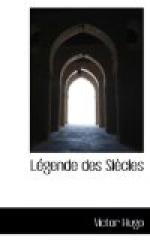cachalot. The cachalot or sperm-whale is one of the largest cetaceans, often attaining a length of more than 80 ft.
le grand mat, the mainmast.
deferle (of a wave), ‘breaks.’
l.38. See the remarks, in the Introduction, on Hugo’s treatment of shadows.
etrave, the stern of a vessel.
etambot, the stern-post.
l.53. The vessel pitches as she meets the waves (le tangage qui brave); the rolling throws up most foam (le roulis qui fume).
eclat, splinter.
fauve, savage, barbarous. See note on EVIRADNUS.
Le dernier siecle. “Pleine Mer” and “Plein Ciel” form a section of the Legende, entitled Vingtierne Siecle.
sur la Tamise. Hugo was hostile to England. He regarded the British Empire as one of the two great dominions the shadow of which was oppressing the world in the middle of the nineteenth century, the other being Russia. England embodied “l’esprit de commerce, de ruse et d’aventure”. He developed this theme with a nervous and forcible eloquence, if not with great political insight, in Le Rhin: Conclusion (published in 1842).
portemanteaux, davits, on which the boats are slung.
grelin, a hawser or warp.
palans, tackle for raising heavy weights; block and pulley.
amure, rope by means of which the lower corners of a sail are held, ‘tack.’
se le passaient, passed it along, i.e. the ship.
Nemrod. Nimrod is in Hugo the incarnation of the spirit of war. Cf. especially La Fin de Satan: Le Glaive.
pavois, as a naval term, ‘bulwarks.’
vrille, gimlet. The conception is of some immense spiked ram.
alcoran, the Koran. Al is the Arabic definite article.
L. 191 refers to the texts in the Koran which order the death of those who do not accept Mahometanism.
simoun, simoon, the hot wind of the Sahara.
PLEIN CIEL.
Analysis.
The vision of a ship in the sky. What is it? It is man, who has burst the bonds that held him to earth and risen into the clouds. It is matter soaring through the heavens.
First lyrical passage. The passage of the ship through the sky.
Description of the life in the ship; the absence of arms; the feeling of power and joy. Description of the ship’s movement.
Second lyrical passage. The voyage amongst the stars.
Whither will man go? He has thrown off his oid nature, his past history is buried, he aspires to immortality.
Third lyrical passage. Is man to reach Heaven without death?
No, man must remain man, but the weight has been taken from his feet. War has vanished; man is good and just.




